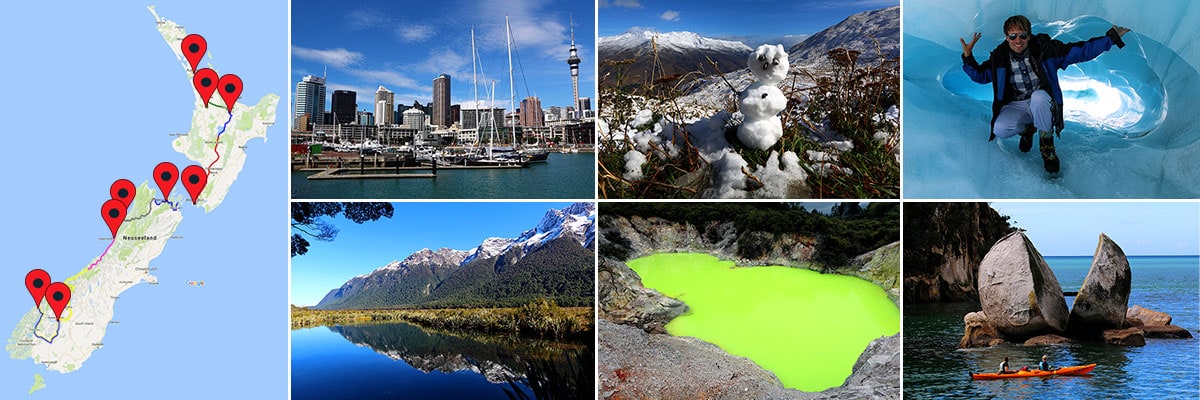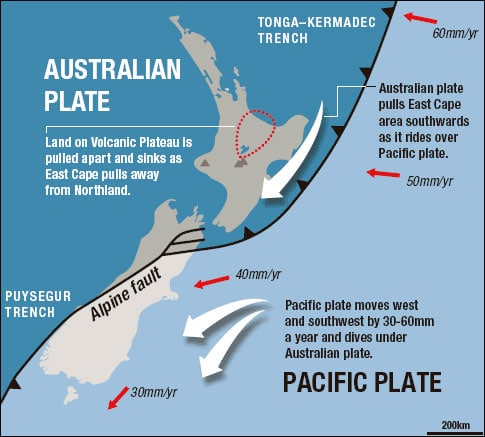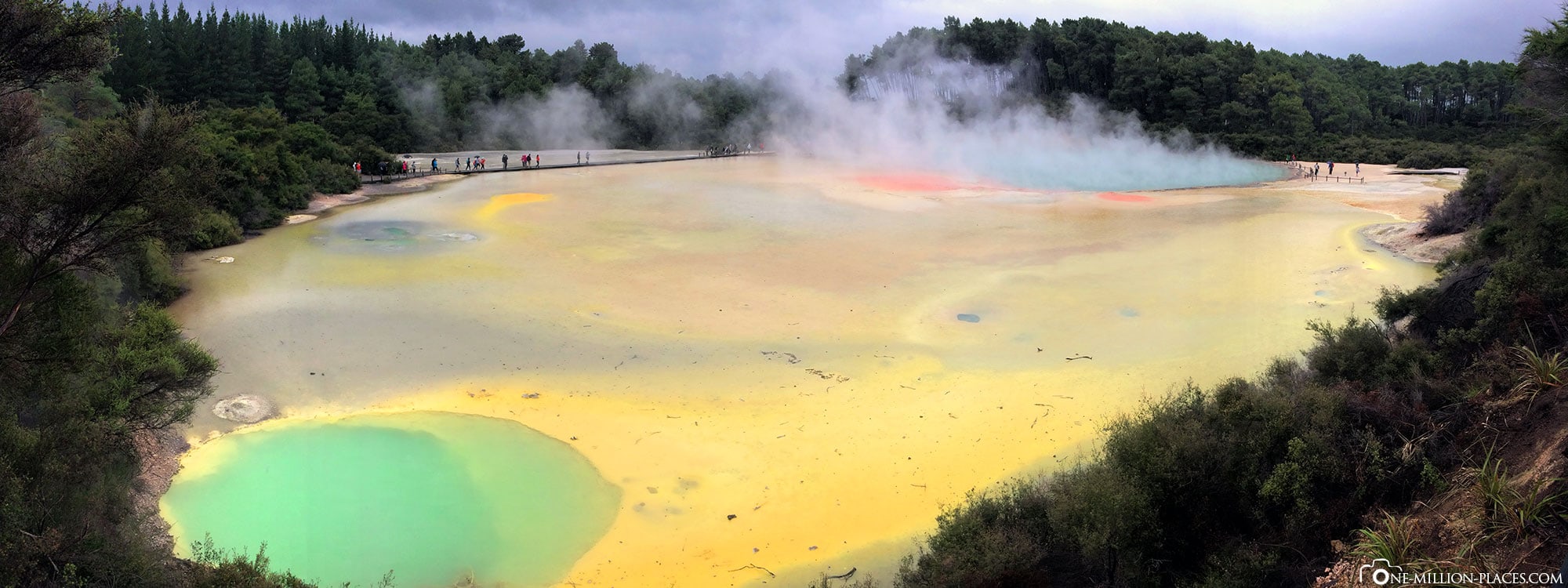This morning our first port of call was the Wai-O-Tapu Thermal Wonderland, which is about 30 km from Rotorua.

Table of contents
Our current route
Today’s day stage on the North Island of New Zealand leads us from our Hotel Accolade Lodge in Rotorua to Wai-O-Tapu, then on to Orakei Korako, then along Lake Taupo to Turangi.
New Zealand – the land of volcanoes & geothermal regions
New Zealand is located on two tectonic plates and is part of the Pacific Ring of Fire, which is the cause of often spectacular geothermal and volcanic activity. On the South Island they meet, are pushed up and thus form the mighty New Zealand Alps. In the center of the North Island, one plate slowly pushes under the other, creating enormous amounts of active underground heat and volcanism. This area, which is concentrated around Rotorua, extends south to the mountains of Tongariro National Park and then east to White Island in the Bay of Plenty. A major outbreak did not take place here until 2019. So you can see all over New Zealand the enormous forces working underground.
The city of Rotorua
The town of Rotorua has about 70,000 inhabitants and is located on the lake of the same name on the north island of Neusseland. The region is best known for its rich Maori culture and geothermal activities in the form of hot springs, bubbling mud holes and the ubiquitous smell of sulfur in the city. In many places, hot steam with sulfur odour emerges from pools and fissures, which is a tourist attraction on the one hand and indicates that the city was built on a volcano. Since the arrival of the first Maori settlers, this enormous renewable energy source has been used for cooking, heating and, more recently, electricity generation.
Among the most famous sights in the Whakarewarewa Valley is the Pohutu geyser. Pohutu means “great buzz” or “explosion”. The Pohutu is the most important geyser in the region and the largest in New Zealand. It breaks up to twenty times a day from reaching a height of up to 30 meters. We made a short photo stop in Kuirau Park, a public park with strong geothermal activity.
The Wai-O-Tapu Geothermal Region
From the city of Rotorua, our journey continued to the Wai-O-Tapu Scenic Reserve – an area of great geothermal activity that originated about 160,000 years ago and is one of the
20 Most SURREAL Places in the World,
according to Tripadvisor. We first drove our car directly to the visitor parking lot and then bought our tickets in the adjacent visitor center. Admission is currently priced at NZD 32.50, which is approximately 21 euros.
The Lady Knox Geyser
After the ticket purchase we drove right back into the car and to the Lady Knox geyser. It advertises that it breaks out exactly at 10.15 a.m. every day. Even though we knew through the “Old Faithful” geyser in Yellowstone National Park that the eruption time of a geyser can be precisely determined, it seemed a bit strange “every day at 10.15 a.m.” Can nature be calculated so accurately? No… Of course not.
The 3 km long circular route through the geothermal area
After visiting the geyser we returned to the visitor centre, from where the 3 km long circular trail through the geothermal area started. The entire site is home to collapsed craters, hot and cold lakes, mudpools and steaming fumaroles. Even though we already knew this from Iceland, Bolivia and Yellowstone National Park, it is always very impressive. Particularly beautiful are the various colours of minerals, which have provided the area with yellow, orange, white, green, red, brown and black spots of color. At the end of the circular path you reach Lake Ngakoro.
Also interesting:
Yellowstone National Park in the United States
The Champagne Pool
One of the highlights of the park is definitely the Champagne Pool with its orange glowing edge.
The Devil’s Bath
We also found the Devil’s Bath with its incredibly striking neon-yellow-green color great!
The Mud Pools
In the end we drove by car to the Mud Pools, which are located just outside the grounds and for which you don’t have to pay any entrance fee.
We spent about 2.5 hours in the park, which we liked very much. Even if the weather didn’t quite play along and it rained again and again, it was a nice visit. With our rental car we drove 40 kilometers to the nearest geothermal region of Orakei Korako.
All travelogues from New Zealand
For 11 days we explored New Zealand from north to south by rental car on our own. We started our trip on the North Island in the city of Auckland, we experienced the tremendous underground forces in Wai-O-Tapu and Orakei Korako, we explored the capital Wellington, drove across the New Zealand Alps, did a glacier hike on the Fox Glacier, before we finished with a trip through the UNESCO World Heritage Site Milford Sound. New Zealand is a really beautiful country that we enjoyed incredibly. » North Island: Auckland – Tourist Attractions, Things to Do & Photo spots (New Zealand)
» North Island: Auckland – Tourist Attractions, Things to Do & Photo spots (New Zealand)» North Island: Waitomo – The Waitomo Glowworm Caves (New Zealand)
» North Island: Rotorua & The geothermal area Wai-O-Tapu (New Zealand)
» North Island: Orakei Korako – The geothermal region in Taupo (New Zealand)
» North Island: The Tongariro Alpine Crossing & the city of Wellington (New Zealand)
» North Island / South Island: Picton – The ferry from the North Island to the South Island (New Zealand)
» South Island: Abel Tasman National Park – Hiking & Boat tour (New Zealand)
» South Island: Pancake Rocks & the Sea Lions at Cape Foulwind (New Zealand)
» South Island: The Franz Josef Glacier in Westland National Park (New Zealand)
» South Island: Fox Glacier – Heli-Hike, Glacier Walk & Ice Climbing (New Zealand)
» South Island: New Zealand Alps – From Franz-Josef to Milford Sound (New Zealand)
» South Island: Milford Sound – A boat trip through the fjord (New Zealand)
» South Island: Road to Milford Sound & the town of Queenstown (New Zealand)



